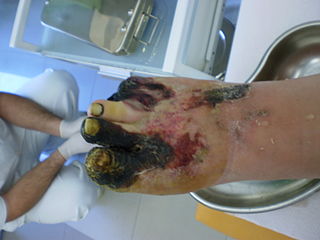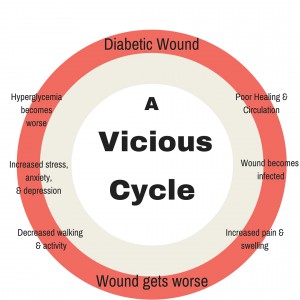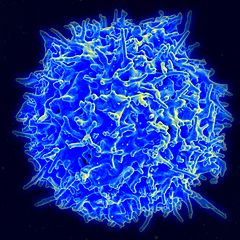
Chronic Diabetic Foot Wound
Back to the Basics
I like to think about Diabetes as the Sugar Disease. Either you have too much sugar (GLUCOSE)
circulating in the blood (HYPERglycemia) or not enough sugar in the blood (HYPOglycemia). Glucose can be manufactured in the body from carbohydrates, starches, sugar added during cooking, and naturally occurring sugars in food. So diabetics really need to be conscious and cautious of foods with large quantities of carbohydrates, starches, preservatives (most are carbohydrate-based), and other sugar naturally present in foods/drinks.
Both hypo- and hyperglycemia has specific signs/symptoms based on blood glucose (sugar) levels. I am going to concentrate on HYPERglycemia because the majority of my patients are hyperglycemic, Type II Diabetics. If you review the chart below, then you will notice poorly managed hyperglycemia and chronically elevated glucose over a period of time causes progressively worse symptoms!
Did you know there is a difference between SYMPTOMATIC and ASYMPTOMATIC? I have had patients that register really HIGH (400+) numbers but are ASYMPTOMATIC (do not demonstrate any of the signs/symptoms) of hyperglycemia. By the time my patients are SYMPTOMATIC, their blood sugars can be 500 or greater! I proceed with caution any time a patient has a blood glucose >220 regardless of being symptomatic or asymptomatic. If my patient has a blood glucose of 220 or greater and is SYMPTOMATIC, I notify the nurse immediately and HOLD all exercises.
Managing diabetes can be tricky and multidimensional. For instance, some patients can control his/her diabetes with a good diet and exercise. Whereas other patients require insulin via pumps or injections, medication(s), special diet regimens, and regular exercise to manage his/her diabetes. For most of my patient’s, the first few factors are a constant battle that he/she generally has very little control over and initiate a repetitive cycle:

To break this cycle, many patients are started on therapy to improve functional strength, circulation, and activity tolerance while simultaneously receiving medical interventions and education to improve diet and manage stress, risk of infection, injury/falls.
 Big Toe Diabetic Sore |
1st Warning Signs of Trouble | Triggers for Diabetic Hyperglycemia | Signs of Uncontrolled and Worsening Diabetes |
|---|---|---|---|
| Glucose Reading >120 | Stress (work/financial, familial, emotional challenges) | Confusion | |
| Blurred vision | Illness and Infections (cold, flu, pneumonia, bronchitis, etc…) | Macular degeneration (permanent loss of vision/blindness | |
| Fatigue | Prolonged inactivity | Increased total body weakness | |
| Increased thirst | Improper use of insulin/diabetic medications or expired insulin/medications | Nausea and vomiting | |
| Increased urination frequency | Poor diet | Difficulty breathing | |
| Headache | Surgeries (joint replacement, heart bypass/stent/defibrillator-pacemaker placement, gall bladder removal) | COMA |
Tips for Hyperglycemia
 Walking …Use it or Lose it
Walking …Use it or Lose it
I can’t say it enough! Walking is the most important, effective and least expensive exercise. I have personally witnessed patients turn their lives around using walking as the fundamental core of their Home Exercise Program not only for diabetic-related problems but for other health problems (i.e. Heart Disease, Parkinsons Disease, Joint Replacement). Not only is walking the easiest form of exercise on the joints, heart, and lungs, it helps decrease depression associated with being isolated in the confining walls of the home. Walking every day, even 20-30 minutes promotes circulation, increases leg strength, controls swelling, and promotes healing. The benefits of walking every day are numerous; therefore, I strive to get ALL of my patients outdoors ASAP to remind them of the opportunities and beauty of life outside of the home — beyond only leaving the home for MD appointments.

Healthy Human T-Cell
Immunity Matters…A Strong Offense is the Best Defense
Community re-entry can boost the immune system! Our bodies (muscles, heart, mind) respond to the forces placed on them! To build muscle strength, you have to exert an additional FORCE on the muscle. The immune system gets stronger the more it is exposed to other germs, pollen, temperature gradients, etc… You build muscle strength gradually and the same goes for the immune system. To gradually build the immune system, I gradually increase the time my patients spend in the front yard, walking to the neighbor’s driveway and eventually around the block. Once my patients conquer walking around the block, I encourage them to go to the park, walk around a grocery store, or enjoy strolling around a mall to increase their exposure to allergens, germs, temperature gradients that stimulate and FORCE the immune system to build a stronger defense!

AVOID/LIMIT
Healthy Eating…You are What You Eat…What Can I Eat with Diabetes?
I like to use this rule of thumb for identifying glucose-high foods/drinks – if something is the color of sugar (white) in its natural state, AVOID/LIMIT the food (i.e. pasta, flour tortillas, sugar, white potatoes, white rice, white bread, and white milk).
Healthy food substitutes can be beneficial. Sweet potatoes, whole grain pasta/bread, yellow corn tortillas, frozen & fresh vegetables, frozen & fresh fruits instead of preservative-packed canned fruits/veggies, shredding your own block cheese (cheese slices and pre-shredded are preserved in carbohydrates), and baking with almond meal, wheat/whole grain flour with decreased added sugar can make a difference!
Diabetes without management is BAD, but it does not mean your food options have to taste like cardboard. I have provided a very tasty almond meal cookie recipe. I have made these sugar-free Chocolate Chip cookies for some of my family and friends with a history of hyperglycemia and Type 2 Diabetes. Everyone in my family and all of my friends that have eaten these Almond Meal Flour recipe cookies rave about them–but most importantly–my diabetic friends are able to enjoy them as well. If you are interested, please feel free to visit my post for the Chocolate Chip recipe or Click Here for the recipe.
Related Products
Diabetic Books |
||||
Diabetic Exercise & Helpful Resoures |
||||
Really fascinating and informative article on Diabetes!
I have to say that the first image of the article really grabs the reader!
I didn’t realize that the lack of healing, and infection were the causes of things like Chronic diabetes foot.
How often do you hand Diabetic patients in PT?
Thank you for the comment and review of my post. As far as your question goes, I am a full-time Home Health PT and because Diabetes has so many residual side effects (chronic swelling, pronounced weakness, poor activity tolerance, wounds, etc…)I can say 90% of my caseload have diabetes + some other illness/injury/disease/disorder. Unfortunately, I have seen and treated several patients that developed a Chronic Diabetic foot wound from something as simple as stepping on a toothpick, tack, or even the teeth of a puppy. They could not “feel” their feet because of the neuropathy so the wound got infected and was out of control before they knew something was wrong.
Usually, my diabetic patients end up requiring additional PT for care and treatment of an amputation. Long story short, I handle a large number of patients with Diabetes.
Hope this answers your question! Thank you again for visiting,
~Shawna PT, MPT
Your article is really a serious matter. The increase number of diabetic is alarming. In my family, many of my uncles and aunts are diabetic. But you are right. Through exercise specially walking can improve their condition.
I believe the picture of a diabetic foot you have shown is the real deal and not some screen capture of a horror film. I feel sorry for your patient to have lost that part of their body. =(
I wish it was just a screen shot, but the culprit was a toothpick! It’s very unfortunate and life changing! Diabetes is a lot more common than people believe or even know, so hopefully with more knowledge and understanding, the tragedy of an amputation can be avoided.
Thank you for the comment and for visiting my site. Let me know if there is anything else I can help with–especially Physical Therapy related.
Have Great weekend,
~Shawna PT, MPT
Hey Shawna,
It’s a very informative article. I am surprised to know so many facts on diabetes. The symptoms table is really an eye opener. I remember my grandma having some of these symptoms as she is diabetic and loads of medicine she takes to reduce them which is wrong. Exercise should definitely be incorporated. Increasing immunity from exercising plays a vital role as you already mentioned. I have personally seen numerous benefits from it. I will share this article and hope people take benefit of it.
Nice work,
Cheers,
Abdul.
Hi Abdul,
I am sorry to hear about your grandmother! Thank you in advance for sharing my article. I truly hope it does open the door to understanding and taking action if someone has symptoms or has been diagnosed with diabetes.
Please let me know if there is anything you experienced and I could comment or share. Your visit and feedback is greatly appreciated. Once again, thank you and I truly appreciate your comments.
Best Regards,
~Shawna PT, MPT